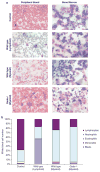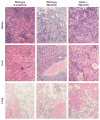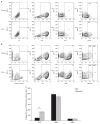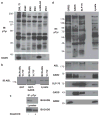Gads (Grb2-related adaptor downstream of Shc) is required for BCR-ABL-mediated lymphoid leukemia
- PMID: 23399893
- PMCID: PMC4981500
- DOI: 10.1038/leu.2013.40
Gads (Grb2-related adaptor downstream of Shc) is required for BCR-ABL-mediated lymphoid leukemia
Abstract
Philadelphia chromosome-positive leukemias, including chronic myeloid leukemia and B-cell acute lymphoblastic leukemia (B-ALL), are driven by the oncogenic BCR-ABL fusion protein. Animal modeling experiments utilizing retroviral transduction and subsequent bone marrow transplantation have demonstrated that BCR-ABL generates both myeloid and lymphoid disease in mice receiving whole bone marrow transduced with BCR-ABL. Y177 of BCR-ABL is critical to the development of myeloid disease, and phosphorylation of Y177 has been shown to induce GRB2 binding to BCR-ABL, followed by activation of the Ras and phosphoinositide 3 kinase signaling pathways. We show that the GRB2-related adapter protein, GADS, also associates with BCR-ABL, specifically through Y177 and demonstrate that BCR-ABL-driven lymphoid disease requires Gads. BCR-ABL transduction of Gads(-/-) bone marrow results in short latency myeloid disease within 3-4 weeks of transplant, while wild-type mice succumb to both a longer latency lymphoid and myeloid diseases. We report that GADS mediates a unique BCR-ABL complex with SLP-76 in BCR-ABL-positive cell lines and B-ALL patient samples. These data suggest that GADS mediates lymphoid disease downstream of BCR-ABL through the recruitment of specific signaling intermediates.
Conflict of interest statement
The authors declare no conflict of interest.
Figures








Similar articles
-
The Grb2 binding site is required for the induction of chronic myeloid leukemia-like disease in mice by the Bcr/Abl tyrosine kinase.Blood. 2000 Jul 15;96(2):664-70. Blood. 2000. PMID: 10887132
-
The src homology 2 domain of Bcr/Abl is required for efficient induction of chronic myeloid leukemia-like disease in mice but not for lymphoid leukemogenesis or activation of phosphatidylinositol 3-kinase.Blood. 2001 Jan 1;97(1):4-13. doi: 10.1182/blood.v97.1.4. Blood. 2001. PMID: 11133737
-
The Bcr-Abl kinase regulates the actin cytoskeleton via a GADS/Slp-76/Nck1 adaptor protein pathway.Cell Signal. 2010 May;22(5):848-56. doi: 10.1016/j.cellsig.2009.12.012. Epub 2010 Jan 14. Cell Signal. 2010. PMID: 20079431
-
Bridging the Gap: Modulatory Roles of the Grb2-Family Adaptor, Gads, in Cellular and Allergic Immune Responses.Front Immunol. 2019 Jul 25;10:1704. doi: 10.3389/fimmu.2019.01704. eCollection 2019. Front Immunol. 2019. PMID: 31402911 Free PMC article. Review.
-
Molecular pathogenesis of chronic myeloid leukemia: implications for new therapeutic strategies.Ann Hematol. 1999 Feb;78(2):49-64. doi: 10.1007/s002770050473. Ann Hematol. 1999. PMID: 10089019 Review.
Cited by
-
The chimeric ubiquitin ligase SH2-U-box inhibits the growth of imatinib-sensitive and resistant CML by targeting the native and T315I-mutant BCR-ABL.Sci Rep. 2016 Jun 22;6:28352. doi: 10.1038/srep28352. Sci Rep. 2016. PMID: 27329306 Free PMC article.
-
[Mechanisms of recombinant adenovirus-mediated SD-HA fusion protein proliferation inhibition and induced apoptosis of K562 cells].Zhonghua Xue Ye Xue Za Zhi. 2018 Apr 14;39(4):314-319. doi: 10.3760/cma.j.issn.0253-2727.2018.04.012. Zhonghua Xue Ye Xue Za Zhi. 2018. PMID: 29779329 Free PMC article. Chinese.
-
GADS is required for TCR-mediated calcium influx and cytokine release, but not cellular adhesion, in human T cells.Cell Signal. 2015 Apr;27(4):841-50. doi: 10.1016/j.cellsig.2015.01.012. Epub 2015 Jan 28. Cell Signal. 2015. PMID: 25636200 Free PMC article.
-
Potential predictive value of serum targeted metabolites and concurrently mutated genes for EGFR-TKI therapeutic efficacy in lung adenocarcinoma patients with EGFR sensitizing mutations.Am J Cancer Res. 2020 Dec 1;10(12):4266-4286. eCollection 2020. Am J Cancer Res. 2020. PMID: 33414999 Free PMC article.
References
-
- Nowell PC, Hungerford DA. Chromosome studies on normal and leukemic human leukocytes. J Natl Cancer Inst. 1960;25:85–109. - PubMed
-
- Rowley JD. Chromosomal patterns in myelocytic leukemia. N Engl J Med. 1973;289:220–221. - PubMed
-
- Sawyers CL. Chronic myeloid leukemia. N Engl J Med. 1999;340:1330–1340. - PubMed
-
- O’Hare T, Zabriskie MS, Eiring AM, Deininger MW. Pushing the limits of targeted therapy in chronic myeloid leukaemia. Nat Rev Cancer. 2012;12:513–526. - PubMed
-
- Konopka JB, Watanabe SM, Witte ON. An alteration of the human c-abl protein in K562 leukemia cells unmasks associated tyrosine kinase activity. Cell. 1984;37:1035–1042. - PubMed
Publication types
MeSH terms
Substances
Grants and funding
LinkOut - more resources
Full Text Sources
Other Literature Sources
Medical
Molecular Biology Databases
Research Materials
Miscellaneous

